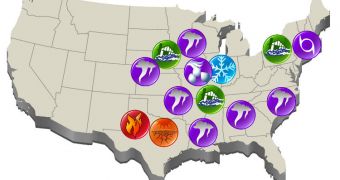Throughout last year, heat and precipitation levels in the United States reached historic levels, and were accompanied by extensive flooding and other severe weather events. Combined, these occurrences led to 2011 establishing a high number of records as far as climate extremes go.
Some of these unusual weather patterns were caused by extensive, recurring La Niña events both in early and late 2011. In addition to impacting North America, these coupled ocean-atmosphere events had deep impacts in other areas of the world as well.
Scientists at the US National Oceanic and Atmospheric Administration (NOAA) just finished compiling an analysis of what went wrong last year, and compiled a few maps depicting the extreme weather and climate events.
The datasets were produced by investigators at the NOAA National Climatic Data Center (NCDC). One of the main conclusions was that 2011 was the 23rd warmest year in recorded history. Mean temperatures throughout last year reached 53.8 degrees F, 1.0 degree F above the 20th century average.
Interestingly, precipitation values were very close to the long-term average, even though record-breaking extremes were recorded in both drought and precipitation. This is one of the perils of statistics, since average data can sometimes block what actually went on.
Due to prolonged La Niña events, average global temperatures were maintained at a steady level, preventing additional global warming. However, this will not last for long, especially not when El Niño, La Niña's opposite, kicks in in the equatorial Pacific Ocean.
Globally, last year tied with 1997, for the position of 11th warmest year on record. “ The annual global combined land and ocean surface temperature was 0.92 degrees F above the 20th century average of 57.0 degrees F (12.9 degrees Celsius)” NOAA experts report.
“This marks the 35th consecutive year, since 1976, that the yearly global temperature was above average. The warmest years on record were 2010 and 2005, which were 1.15 degrees F above average,” the team explains in a press release.
“Separately, the 2011 global average land surface temperature was 1.49 degrees F above the 20th century average of 47.3 degrees F and ranked as the eighth warmest on record,” the document adds.

 14 DAY TRIAL //
14 DAY TRIAL //